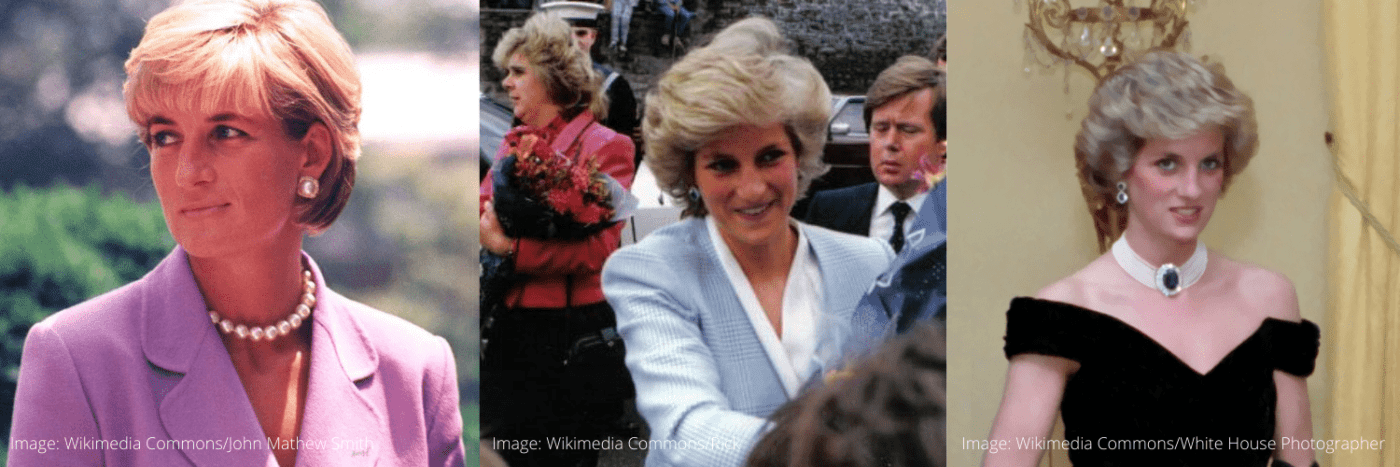Princess Diana: fashion icon and trailblazer
CW: one mention of eating disorders
As a Princess, Diana’s struggles with mental health and the problems that came with her marriage are well known, but what is less commonly known is that she used fashion as a political tool of empowerment.
From kitted cardigans, polka dots and revenge dresses, to the head visor she wore while protesting landmines in Angola, every outfit Diana wore tells a story. Each piece of clothing holds significance. Surrounded by intrigue, the abuse of power, aggression, affairs and a lack of people she could trust, Diana used the one thing she could control – her clothing.
The early 1980s:
During the early 1980s, Diana wasn’t much interested in a boyfriend, let alone a Prince. When it came to fashion, Diana said: “I knew I had to keep myself very tidy for whatever was coming my way.”
Her teenage outfits reflected her upper-class conservative morality, usually involving styles such as pie-crust collars, ill-fitting blouses, tartan smocks, blazers and high necklines. Her identity was defined by decorum.
Diana was described by a news reporter as “aristocratic, good looking and well-heeled.’’ Many of her early outfits from the period when she was courting Prince Charles reflect this. One memorable look comes from the infamous “whatever love means” engagement interview. Diana wore a royal blue skirt suit, black clutch and frilly blouse. Even in the impression of her being a 19-year-old deer in the headlights, there is an early shadow of her ruthless charm and beauty.
Her outfits became a contrast to the turmoil she experienced in her personal life
During the springtime of her marriage to Prince Charles, Diana enjoyed polka dots and large hats, especially at high-profile royal events. She wore baby pinks, powerful floral statements, and to offset the sheer strength of her innocence, more pallid whites and yellows.
Her clothes spoke of hopeful immaturity, and a raw beauty which would be chastened by living with indifference and discontent. She would lose her softness but gain strength and self-confidence.
Diana was set to the task of proving herself as Princess of Wales overnight of England, but this was too much to ask of a 19-year-old. Diana’s private world became embarrassing to the Royal Family, filled with eating disorders, loneliness and the Camilla question. As a result, her outfits became a contrast to the turmoil she experienced in her personal life. Her beauty floated around her. Her private life was a sophisticated nightmare and catastrophe, but she dressed like a daydream.
The late 1980s/early 1990s:
Towards the late 1980s, the mask soon began to crack on Charles and Diana’s marriage with stories of separate lives and infidelity rumours. Diana had become wary and perhaps even complacent with the media, aware that though she was a hunted woman, she could use the media pundits to her own advantage. In short, she could tell her own story.
Her suits became a symbol of the power she could exert through the media. Through a visit to the Taj Mahal in 1992, she sat by herself, elegant and melancholy in front of the world’s greatest temple which symbolised love.
She allowed the camera to photograph this movie magic moment as a silent act of war upon her husband. Memorable looks include the pink and purple-trimmed skirt suit she wore to Ascot in 1990 and the blue and white buttoned suit she wore on tour in Egypt in 1992. Towards the end of her marriage, her powerful androgynous suit style shows her growing independence. As she would later say: “I can do this job so much better on my own.” As it turns out, she could.
The 1990s:
In the spring of 1991, Princess Diana asked Andrew Morton to write a book about her life as Princess of Wales. At this moment Diana turned from victim to victor. She also did this through her dresses. After years of being a metaphor for victimhood, she went from hunted to the huntress, a femme fatale in her own right. She was both erotic and menacing.
Striking examples are the scarlet off-the-shoulder gown she wore to the Just Like a Woman premiere in 1992 and the black silk Christina Stambolian gown, more affectionately known as the ‘Revenge Dress’ worn by Diana to the Serpentine Gallery summer party in 1994. This was the night Prince Charles admitted to foul-play with the ‘third person’ in the marriage, Ms Parker-Bowles.
Revenge may be a dish best served cold, but with the dress’ form-fitting quality, off-shoulder, black sheer tights, stilettos and a choker, Diana wore her unapologetic sexuality and lukewarm rage for all the world and her husband to see.
Then, a new woman emerged
Charles and Diana separated in 1992. In August 1996, the prince and princess reached a final divorce settlement. As Diana’s old existence died, her clothes took on a shade of mourning through blacks, reds and other tragic colours.
Then, a new woman emerged – Diana, the huntress, humanitarian and people’s princess, with an incorrigible optimism and firm belief in herself, after going through hell. Little did she know, however, that just around the corner loomed that fatal car accident, and in many ways, in 1996, she entered the evening of her existence.
Diana was a woman of heart, mind and mythological style and beauty
One of the strange ironies of Princess Diana, as her brother Earl Spencer pointed out in a speech after her death, was that for a woman named after the Goddess of War, she was the most hunted woman in the late 20th century.
Perhaps it was the gift of life she carried that brought her closer to death but Diana was a woman of heart, mind and mythological style and beauty. It is hard to refuse the elegance of a woman who overcame a tower of sexist-oppressive cliches and disloyal husbands, and who could do it all in a little black dress.

Comments